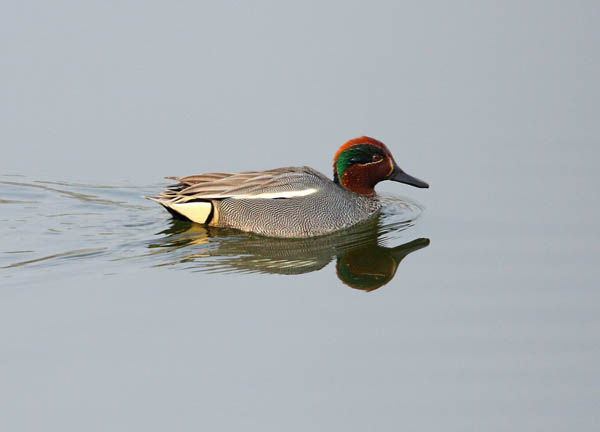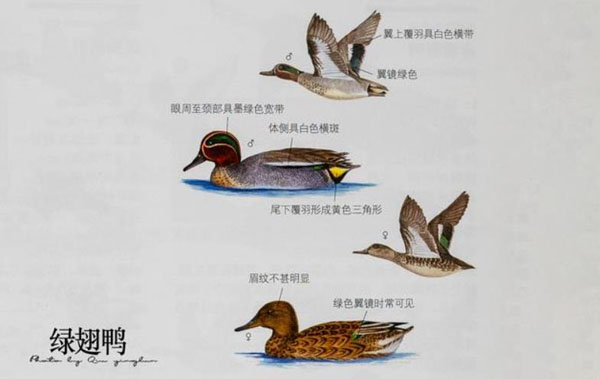Anas crecca
IUCN
LCBasic Information
Scientific classification
- name:Anas crecca
- Scientific Name:Little duck, little teal, little mallard, duck, duckling, clam duck,Anas crecca,Common Teal,Green-winged,Teal Eurasian Teal
- Outline:Waterfowl
- Family:Anseriformes Anatidae Duck
Vital signs
- length:306-470mm
- Weight:205-398g
- lifetime:8-10years
Feature
There is a wide green band on both sides of the head starting from the eyes and extending to the sides of the neck, which is very eye-catching.
Distribution and Habitat
In China, it breeds in Xinjiang and Northeast China, and hibernates in various waters in the Yellow River and south of it. Abroad, it breeds in the entire Palearctic and hibernates in the southern part of its distribution area.
In the non-breeding season, it inhabits most waters such as rivers, reservoirs, lakes, paddy fields, ponds, swamps, sandbanks, lakes, bays and coastal areas, and often gathers in large groups, often mixed with small river ducks.
Appearance
Small in size, the male has a dark brown head and neck, with a wide dark green eye mask with a golden edge starting from the eye, extending to the side of the neck. The shoulder feathers have a long white stripe, the flanks have worm-like fine lines, the undertail coverts are black with a yellow spot on both sides, the wing mirror is dark green, and the rest of the body feathers are gray-brown. The female is gray-brown all over, with a lighter head and a dark eye pattern, and the wing mirror is dark green. The iris is brown, the beak is gray-black, and the feet are dark brown.
Details
Green-winged ducks like to gather in groups, especially during the migration season and winter, often gathering in large groups of hundreds or even thousands of them. They fly fast, agile and powerful, with fast and loud wings flapping, and their heads stretched forward, often in a straight line or "V" formation. They take off very skillfully on the water surface, sometimes soaring straight into the sky, and sometimes flapping their wings and skimming a distance on the water surface before rising from the water. They are also very good swimmers, but they are a bit clumsy when walking on land.

In winter, they mainly feed on plant food, especially seeds and young leaves of aquatic plants, and sometimes go to nearby farmlands to forage for grains scattered on the ground after harvest. In other seasons, in addition to eating plant-based food, they also eat snails, crustaceans, mollusks, aquatic insects and other small invertebrates. They mainly forage in shallow water near the water. They mostly forage in the early morning and dusk, and sometimes at night and during the day. They forage for a long time every day. They rest mostly on the waterside, sandbars and small islands in the lake.

They begin to migrate northward from their wintering grounds in southern China in early March every year, and appear in large numbers in Northeast China and North China from mid-to-late March to mid-April. They often migrate in large groups of 40-50 or even hundreds of them. They fly fast, forming a line or a ‘V’ shape, flapping their wings very fast, making a ‘whoosh’ sound. Autumn migration begins in early and mid-September, reaching the Yangtze River Basin in mid-to-late September, and arriving in the coastal areas of Guangdong in early October. The peak migration period is from late September to late October, and a few individuals stay in Northeast China and North China to overwinter.
They breed throughout the Palearctic and overwinter in the south. They are sexually mature at the first age, but not all of them can participate in reproduction, and some do not begin to reproduce until the second age. Most pairs form during the winter overwintering period, and a few pairs form during the spring migration route. They start to build nests soon after arriving at the breeding grounds. The breeding season is from May to July. They build nests on the shores of lakes, rivers and other water bodies or on the ground in nearby grass and bushes. The nest is extremely hidden. It is a simple nest made of reeds, rushes and feathers. It is usually a pit with a little hay inside and surrounded by down feathers. Each nest lays 8-11 eggs. The eggs are white or light yellowish white, 41-49 mm × 30-35 mm in size, and weigh 25-30 grams. The female bird incubates the eggs, and the male bird leaves the female bird to molt in a quiet area at the beginning of incubation. The incubation period is 21-23 days. The chicks mature early and can walk and swim soon after hatching. They can fly after more than 30 days under the guidance of the female bird.

Green-winged teal used to be quite abundant in China. Not only was it widely distributed, but the number was also extremely large. During migration, tens of thousands of them, one group after another, passed through the sky like a group of dark clouds, spread across the waters of southern China. It is the most numerous and common industrial hunting bird in China. But it is difficult to see such a spectacular scene, and the population has decreased significantly. According to the Asian Midwinter Waterbird Survey organized by the World Waterfowl Research Bureau in 1990, there were 37,967 in China, 189,136 in Japan, and 638,254 in Asia. There are 250,000 in northwestern Europe, 750,000 in the Mediterranean and the Black Sea, and 3 million in North America (North American subspecies). The overall population is still quite abundant.








